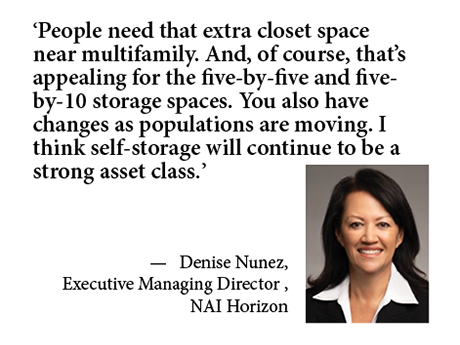Self-storage has had an amazing run since just before the pandemic. Cap rates started near 6 percent, with buildings starting at $150 per square foot. Then came the flood of pandemic capital pushing prices — by mid-2022 prices jumped to a point no one had previously experienced.
“In some of the bigger markets, we were seeing per-square-foot prices of $300 and above for the first time,” says Denise Nunez, executive managing director with NAI Horizon. Cap rates fell to as low as 4 percent. “The low cap rates had gotten to such a point where many brokers were not even pricing deals because they didn’t want to miss that extra that they could get on the sale.”
But rising interest rates have had an impact on self-storage, as they have had on every other commercial real estate asset class, with prices reversing again. Investors are still unsure of what the Federal Reserve will be doing in the near term with monetary policy. Building costs are high — final delivery construction costs are still higher by 40 percent or more than pre-pandemic. That reality has resulted in investors alternating between cold feet and, with some signs that the Fed may plan to moderate interest, a rebound.
Some “more institutional companies” have sold off properties and entire portfolios. “And they were really the ones that were pushing the cap rates down by driving prices up,” Nunez says. The sell-offs could mean companies are taking profits while expecting valuations to come down.
As a result of the sell-offs and persistent higher interest rates, deal dynamics have changed. It’s harder for virtually anyone to get financing, so approaches are shifting from getting traditional loans. If there is enough room in NOI, sellers can have the ability to carry a mortgage for part or all of the purchase price. Nunez says there is more use of seller carryback financing. Prices vary by such factors as location and whether leasing up is stabilized — in other words, back to a more traditional approach.
The New Self-Storage Market
Even as some big institutional players have exited, other buyers are coming in.
“I found myself really having to work harder to get deals,” says Nunez. “But the beginning of fall has always been a period where people come off their vacations and they really focus in on business. Now we are slammed, doing a lot of broker opinion of values (BOVs) and advising on deals.”
“There are a lot of multifamily owners and investors looking at self-storage,” Nunez says. “I understand that, at least for the Arizona market, new development for multifamily is really going to drop off significantly in 2025. So, if you’re looking down the road, you say, ‘Okay, I need to probably reposition a little.’” And where there is multifamily, there is frequently a need for self-storage, especially as an off-site extension to an apartment, which makes the property type a natural adjacent buy.
“People need that extra closet space near multifamily,” Nunez explains. “And, of course, that’s appealing for the five-by-five and five-by-10 storage spaces. You also have changes as populations are moving. I think self-storage will continue to be a strong asset class.”
“We’re also seeing a lot of cash buyers, a lot of funds and new funds being created,” says Nunez, though there is also a lot of capital being held to the side. “The buyers don’t want to pay those prices even though the sellers have come down a bit. They still want to be able to negotiate.”
Another new factor will likely be significant as a result of mergers and acquisitions among large players. “Think about all the high-level executives who have not landed in new places,” Nunez says. “I’m talking to many of them on a regular basis. They’re sharp, smart people. They’re out there and are probably going to start funds. We’re going to see some interesting things happen over the next six to eight months. A lot of new focus on acquisitions for self-storage. Ideally, they’d like to see some distressed assets.”
It can be a good time to buy during these market alignments, Nunez says. One strong piece of advice she offers is to learn about the business and how it works. She points to a northwest market deal where someone built a 180,000-square-foot property that hadn’t moved off 17 percent occupancy.
“I don’t think the developer did its homework. Institutional-quality facilities supported by the REITs are on average about 75,000 square feet,” Nunez explains. “You have to have significant high-rise density to support 180,000 net rentable square feet. At a certain point, you become your own competitor. If you don’t know the business, then uneducated decisions turn into problems for you and opportunities for others.”
— This article was written in conjunction with NAI Global, a content partner of REBusinessOnline. For more articles from and news about NAI Global, click here.


